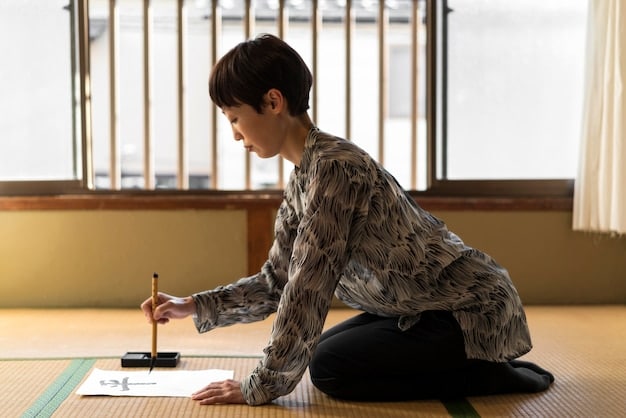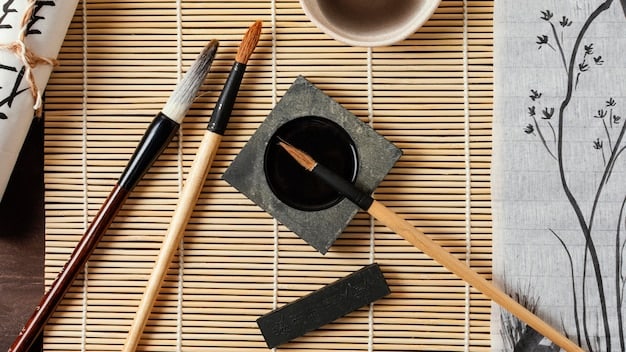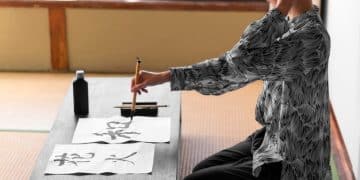Zen Calligraphy for Beginners: A Mindful Journey to Self-Expression

The Beginner’s Guide to Zen Calligraphy: Expressing Yourself Through Mindful Brushstrokes offers a comprehensive introduction to this ancient art form, blending artistic technique with Zen principles to cultivate mindfulness and self-expression.
Embark on a transformative journey with The Beginner’s Guide to Zen Calligraphy: Expressing Yourself Through Mindful Brushstrokes. Discover how this ancient art form can unlock your creative potential while cultivating inner peace and mindfulness. Learn the fundamentals, from selecting the right tools to mastering essential brushstrokes, and begin to express yourself through the profound beauty of Zen calligraphy.
Discovering Zen Calligraphy: A Path to Mindfulness
Zen calligraphy, or *shodo*, is more than just beautiful writing; it’s a meditative practice. Rooted in Zen Buddhism, it’s a way to express oneself through mindful brushstrokes, connecting deeply with the present moment. This art form offers a unique blend of artistic skill and spiritual discipline, accessible to anyone seeking tranquility and creativity.
The beauty of Zen calligraphy lies in its simplicity and intention. Each stroke is deliberate, reflecting the artist’s state of mind and connection to the universe. By learning the fundamentals, you can begin to unlock your own artistic potential and experience the profound benefits of this ancient practice.
The Essence of Shodo: More Than Just Writing
Shodo encapsulates the essence of Zen philosophy, emphasizing the flow of energy and the importance of being present. It teaches us to observe our thoughts and emotions without judgment, allowing us to express ourselves authentically.
Connecting the Mind, Body, and Spirit
The act of creating Zen calligraphy requires a deep connection between the mind, body, and spirit. It’s a holistic practice that promotes relaxation, focus, and self-awareness. The mindful brushstrokes become a physical manifestation of your inner state.
- Mindfulness in Motion: Transforming writing into a moving meditation.
- Breath and Brush: Coordinating your breath with each stroke for enhanced focus.
- Embracing Imperfection: Recognizing the beauty in asymmetry and spontaneity.
- Finding Flow: Allowing the ink to dance freely across the surface.
Zen calligraphy provides a unique opportunity to cultivate mindfulness and express yourself in a meaningful way. Whether it’s through the creation of a simple character or an elaborate composition, the practice offers a path to inner peace and self-discovery. By embracing the principles of Zen, you can unlock your creative potential and find harmony in the present moment.
Essential Tools for Zen Calligraphy Beginners
To embark on your Zen calligraphy journey, you’ll need a few essential tools. Choosing the right materials can significantly enhance your experience and help you achieve the desired results. Investing in quality supplies is a worthwhile endeavor, as they will last longer and provide a more enjoyable creative process.
While the array of calligraphy tools can seem overwhelming at first, focusing on the basics will set you on the right path. With the right tools, you’ll be well-equipped to begin exploring the art of mindful brushstrokes.

Brushes: The Heart of Zen Calligraphy
The brush is undoubtedly the most important tool in Zen calligraphy. Different brushes are used for different types of strokes and characters. Generally, brushes come in various sizes and bristle types, catering to diverse calligraphic styles.
Ink and Ink Stone: The Essence of Expression
The ink and ink stone are essential elements in Zen calligraphy. The preparation of the ink is a ritual in itself, involving grinding the ink stick on the ink stone with water. This process allows you to connect with the art form on a deeper level.
- Brush Selection: Exploring different brush types for varying effects.
- Ink Quality: Choosing the best ink to enhance the quality and longevity of your artwork.
- Paper Selection: Selecting paper specifically designed for calligraphy to manage ink bleed.
- Other Essential Tools: Water droppers, weights, and cloth materials that all have unique purposes in calligraphy.
Gathering the right tools will allow you to immerse yourself fully in the art of Zen calligraphy. Each element plays a vital role in the creative process, contributing to the overall experience of mindful expression. By taking the time to select your materials carefully, you’ll be well-prepared to embark on a fulfilling and transformative journey.
Mastering the Basic Brushstrokes in Zen Calligraphy
Mastering the basic brushstrokes is crucial for any aspiring Zen calligrapher. These fundamental strokes form the foundation of all characters and compositions. By practicing these strokes diligently, you’ll develop the necessary skill and control to express yourself with confidence and precision.
The key to mastering brushstrokes is to focus on quality over quantity. Pay attention to the pressure, speed, and angle of your brush, and strive for consistency in each stroke. Patience and perseverance are essential, as it takes time and practice to develop proficiency.
The Horizontal Stroke ( 一 )
The horizontal stroke is perhaps the most fundamental stroke in Zen calligraphy. It represents the earth and the foundation of all things. Mastering this stroke is the key to balancing your energy and building a solid foundation for more complex characters.
The Vertical Stroke ( 丨 )
The vertical stroke symbolizes heaven and the connection between the earthly and the divine. It represents strength, stability, and the flow of energy from above to below. Practicing this stroke involves maintaining a straight line while modulating pressure.

- Diagonal Strokes: Balancing direction and pressure is key to perfecting this style.
- Dot Strokes: Quick bursts of ink on the page contribute to the depth of characters.
- Curved Strokes: Graceful arc patterns that give calligraphic pieces motion.
- Combining Strokes: Practice combining the fundamental strokes to form simple characters.
By mastering the basic brushstrokes, you’ll gain a solid foundation for exploring the more complex aspects of Zen calligraphy. With patience, practice, and a mindful approach, you can unlock your creative potential and express yourself with beauty and grace.
The Art of Composition: Balance and Harmony
The art of composition plays a significant role in Zen calligraphy. It’s about arranging the elements of your artwork in a way that creates balance, harmony, and visual appeal. A well-composed piece of calligraphy evokes a sense of tranquility and invites contemplation.
When composing your calligraphy, consider the placement of each character, the spacing between lines, and the overall flow of the piece. Experiment with different arrangements to find the most pleasing and balanced composition. Remember, the goal is to create a work of art that is both aesthetically pleasing and spiritually meaningful.
- Symmetry and Asymmetry: The balance between these is key to creating compelling and moving compositions.
- Empty Spaces: The parts that are not there give definition to the parts that are.
- Rule of Thirds: A compositional system that makes work easier in art in general.
Finding Your Style: Experimentation and Expression
As you progress in your Zen calligraphy journey, it’s essential to explore your own unique style. Experiment with different brushstrokes, compositions, and techniques to discover what resonates with you. Don’t be afraid to break the rules and express yourself in a way that feels authentic.
Your personal style will evolve over time as you continue to practice and refine your skills. The key is to remain open to new experiences and allow your creativity to flow freely. Embrace the journey of self-discovery, and let your Zen calligraphy reflect your inner world.
Embracing Spontaneity and Intuition
Allow your intuition to guide your brushstrokes and trust the process. Zen calligraphy is about letting go of control and allowing the ink to flow freely.
Connecting With Your Inner Voice
Let your calligraphy reflect your unique perspective and experiences. Use your art to express your thoughts, emotions, and aspirations.
Zen Calligraphy as Meditation
Zen calligraphy offers many meditative benefits. It’s a practice that brings you into the present moment, cultivating focus, concentration, and inner peace. It provides refuge from the stresses of daily living by offering an escape that is both artistic and rewarding.
Use the practice to center yourself each day and to calm your mind. With practice, you will find that both your abilities as a Zen calligrapher increase and your mental health improves incrementally.
| Key Point | Brief Description |
|---|---|
| ✍️ Basic Strokes | Master horizontal, vertical, and curved strokes. |
| 🧘♀️ Mindfulness | Focus on the present moment during practice. |
| 🖌️ Essential Tools | Use the right brushes, ink, and paper for optimal results. |
| 🎨 Composition | Balance elements and create harmonious layouts. |
Frequently Asked Questions
▼
Zen calligraphy is a way to purify your mind and express your true self, allowing you to connect with the present, emphasizing simplicity, naturalness, and spontaneity.
▼
Zen calligraphy is about expressing yourself in the moment, so it’s definitely better to learn without an aid like stencils to get the true spiritual nature of the art.
▼
Yes, there are indeed particular types of ink that work best with traditional calligraphy. In general, make sure to find inks that are more viscous than fountain pen inks.
▼
Zen calligraphy can be learned quickly. With dedicated practice and training, you may learn and begin to execute the art in as little as three months’ time.
▼
There are three factors you should consider when choosing your paper. Namely, these are absorbency, thickness, and bleeding, all of which work in conjunction.
Conclusion
In conclusion, Zen calligraphy is much more than just an art form. It’s a pathway to mindfulness, self-expression, and inner peace. By embracing the principles and practices outlined in this beginner’s guide, anyone can begin to unlock their creative potential and embark on a transformative journey of mindful brushstrokes. Remember, the key is to approach the art form with patience, perseverance and a deep connection to the present moment.





